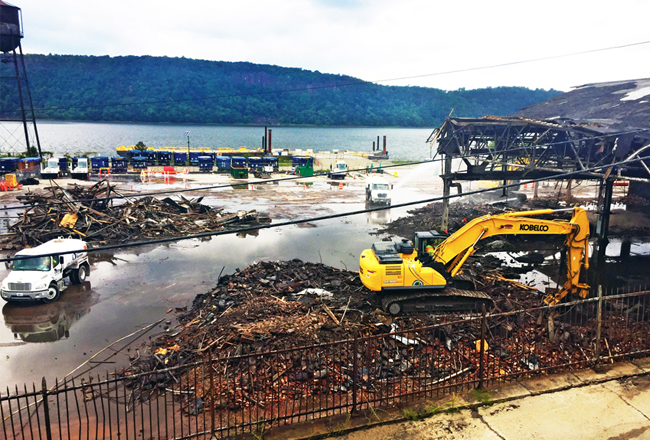
After years of waiting and wishing, residents and business owners in Hastings-on-Hudson are finally beginning to see changes coming to their waterfront.
Earlier this summer, demolition work began on Building 52, a red-brick industrial building on the Hastings waterfront dubbed the “literal birthplace” of polychlorinated biphenyls.
Atlantic Richfield Co. removed asbestos and other materials from the building interior prior to beginning demolition of the structure in August, when construction crews used excavators and other heavy machinery to bring down the century-old building piece by piece.
It”™s a welcome sight for many who call Hastings their home. At the village”™s Metro-North train station, which sits just above Building 52 and affords views of the ongoing demolition, commuters stood along the rails nearest the site, documenting the progress with videos on their cellphones and snapping selfies with the crumbling structure as their background.
“It’s sad to see the old building go, but it is nice that finally there’s progress,” said Ellen Sledge, owner of Penny Lick Ice Cream at 580 Warburton Ave.
Sledge said that she has heard talk of the redevelopment of the waterfront since she first moved to the area nearly a decade ago. “I”™m still thrilled,” she said, “but if this is the pace it is going to go at, I don”™t have high expectations of this (redevelopment) happening anytime soon.”
The demolition is expected to be completed by the end of the month, according to Hastings-on-Hudson Mayor Peter Swiderski, and will be followed by a cleanup of debris that could last through November. The full remediation of the 28-acre waterfront property, owned by Atlantic Richfield, a BP PLC subsidiary, is expected to take five years.
Stan Avedon, partner at Hastings Velo, a cycling shop at 45 Main St., said the remediation of the area surrounding Building 52 marks the beginning of a new era for the riverfront village. “Being one of the last large undeveloped areas along the lower Hudson River, redevelopment will be very impactful,” he said.
Constructed in 1911, Building 52 was originally used as a sheet mill by the National Conduit & Cable Co. and the National Brass & Copper Tube Co. In ensuing years, the industrial property was the site of large-scale and occasionally violent labor union strikes, including one in 1912 in which strikers broke every window of the building. In 1916, a group of 200 women attacked strikebreakers entering the structure and encouraged 1,500 workers in a two-day revolt, leading to the National Guard being called to the site.
The site is most widely known as the former location of Anaconda Wire and Cable Co., the company that acquired the property in 1929. During World War II, the company manufactured a fire-resistant electrical cable there under a contract with the U.S. Navy. Its manufacturing included polychlorinated biphenyls, the cancer-causing organic chlorine compounds known as PCBs, which led to the contamination of the site. Other toxins on the property include copper, lead and zinc.
Anaconda”™s facility was closed in 1974 and purchased by Atlantic Richfield in 1977.
Though initially Atlantic Richfield and the village planned to cap pollution beneath Building 52, the company shifted its position and determined that to better remediate the site the building would need to be brought down.
“Building 52 has a storied history in Hasting”™s past, and it is a bittersweet moment to see the building go,” Swiderski said in an email to residents. “Though its profound pollution condemned it to demolition, it still represents a monument to our village”™s past industrial might.”
Atlantic Richfield signed an order in 2014 with the state Department of Environmental Conservation in which it agreed to fund the more than $250 million estimated cost of removing the contaminated soil and sediment from the property, designated a federal Superfund brownfield site.
The demolition of the structure also comes more than a year after the village signed a consent decree that sparked the cleanup. The July 2016 decree is an update to a 2003 version that settled a lawsuit between Atlantic Richfield, the village and environmental group Riverkeeper and forced Atlantic Richfield to clean the site. Since then factors, including potential storm risks, rising sea levels and a new set of directives issued by the state Department of Environmental Conservation required changes to the agreement.
While the village watches as the building is brought to the ground, many continue to question the fate of the other eye-catching structure on the property: a water tower.
Situated above a “substantial pocket of pollution,” the water tower has always been slated for removal, Swiderski said, though whether the project includes restoring or recreating a new tower remains to be seen. The village plans to reach out to residents in the coming weeks to solicit feedback regarding the fate of the water tower.
The village also plans to rezone the waterfront parcel from marine industrial use in the coming year, a process that could prove key for area business owners.
Peter Rockwood, president of Rockwood & Perry Fine Wine & Spirits at 525 Warburton Ave., said that if the village elects to create a separate downtown area along the waterfront, that could hurt businesses like his.
“Frankly, I don’t think that will happen,” Rockwood said of the creation of a separate riverfront shopping area. He added that he thinks new recreational or residential development on the postindustrial site would have a positive impact on Hastings”™ small businesses.
Local business owners agreed that the redevelopment of the waterfront property could spur additional foot traffic to downtown businesses.
“It would be nice to see something there that the community could be proud of,” said Sledge, adding that she does not believe the site would be well-suited for a large-scale residential development.
“I think that right now, almost anything is a positive change,” she said.























Hastings has been plagued with Swiderski for years. By far the worst Mayor in the Rivertowns and certainly in Hastings history. No foresight, no spine, BPs butt boy. Making the village over in his image, faceless mediocrity.
Swiderski is just one in a line of mayors who’ve been in bed with whatever fat-cats own that property! No regard for our village’s history or character, no regard for the environment or the right of the people to have access to the waterfront and to keep historic buildings. It’s been the case since the 1910’s with the infamous «dock scandal » when the then mayor agreed to allow Anaconda Cable and Conduit to trade a 30 foot strip of land for the peoples’ access to the waterfront at the dock. Again in the 40’s another mayor traded the peoples’ other dock for some « underwater property » which they proposed to fill with garbage in order to make a park and for an additional $10,000, claiming that by the time the park was constructed New York State would have cleaned up the Hudson River, meaning that people could once again swim and fish! Of course, the people didn’t let the town fill 200 sq. Feet of river with garbage and so no Park was built. $3,000 of the 10,000 went to a lawyer and obviously seven thousand dollars has screwed Hastings residents for the ensuing 70 years! Mayors like McEachron and Kinally were eager to tear down buildings, and the corperate scum-bags who arranged to pay for « redevelopment studies » were well aware that the sites were far too contaminated to be inhabited by humans; billing the venture as a potential way to reduce the town’s enormous tax rate, the wealthy owners of near-every property from Tappan Terminal to what are comically now known as « kinally cove and McEachron Park » ridded themselves of their massive liabilities and their worthless properties without needing to spend a dime on remediation, meaning that it is the townspeople who fill foot the bill in the end!! Sour grapes for people who vote for small-town crooks like Swiderski! Of course, BP has now done the same as the other site-owners, yet they were late in the game and had to spend a few million dollars on demolition, new sports equipment for the school, a few police and fire vehicles which the town will never use and sure doesn’t need and one eco-friendly buggie without any practical use. That may sound like a lot to small-town morons, but it is clear that we are being duped! Does anyone think BP is doing this out of the good of their heart or concern that a wealthy suburb needs some moderately expensive sh*t that they can’t afford?? OF COURSE NOT!! It’s about profit! And they have the board of trustees, the mayor and the fire inspectors all lining up to service them!